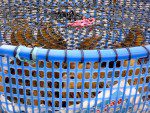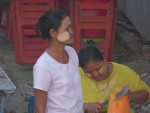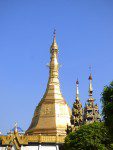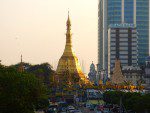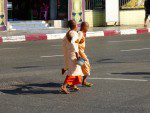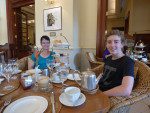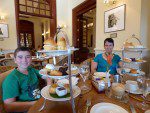First chaotic impressions of Yangon
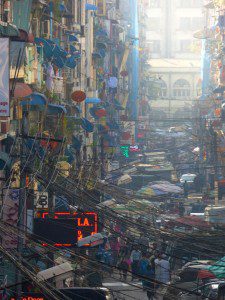
They drive on the right in Myanmar, but their cars are all right-hand drive. That’s not a bad metaphor for the confusion that is Yangon.
We had a good, perhaps even great, flight with no signs of the travel-sickness that has plagued our last few plane journeys. In a sign of them getting older we left the boys to pick up the luggage while Jennifer and I changed money and bought local SIM cards. Then we descended into the maelstrom of Yangon traffic which made a 15km drive take over an hour. Like most night-time journey’s from airports we had only fleeting glimpses of this place, most of which simply conveyed a sense of utter chaos.
This morning we went for an exploratory walk to get a better feel for what Yangon is like. The main markets are just down the road so we wandered through them and watched people opening their shops. The shops largely sell fabrics and precious stones. At around 9am the shops were just sleepily opening up which didn’t matter because we weren’t going to buy anything anyway. We don’t need the fabric and the precious stones are mined in horrifying circumstances.
The surrounding streets were far more interesting though, filled with activity and bustle as people had breakfast in roadside stalls, carried huge burdens to shops, or started selling their wares. Shaven-headed Bhuddist monks and nuns wandered through the crowds carrying looking for alms. At one corner ice was being cut into bricks from huge slabs melting onto the road. Another had a small fruit stall, jammed in beside a lottery ticket seller, sitting side-by-side with someone selling instant coffee from a jug. Overhead wires tangle everywhere while the sides of the buildings are festooned with satellite dishes.
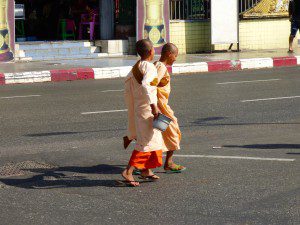
Everywhere men and women wear the longi – a colourful bolt of cloth wrapped around the waist. Most women have smears of ground bark covering their cheeks as a cosmetic and sunscreen. And they’re all carrying mobile phones. Everywhere there was a sense of the traditional, and clearly quite poor, lifestyle rubbing shoulders with the modern and increasingly well-off.
Technically Burma is not the poorest country we’ve visited, but thanks to enormous inequality it has some of the poorest people. The inequality is far from new – the temples are literally covered in gold thanks to the alms extracted from people who have little to give. Burma has always been a very rich country for those at the top – it was that richness that led to the British taking over after three entirely contrived wars of acquisition.
By the time we finished walking, the Sun was well and truly up and the day was hot. So it was time for a swim and some sitting around by the pool, to recover some energy before setting out again.
Our afternoon walk took us down to the river. Now don’t get the impression that by ‘walk’ I mean stroll. Walking in Yangon means joining the traffic on the street in a welter of honking horns, exhaust, and shouting people. It’s smelly, and chaotic, and wonderful in its way. It is not, however, relaxing.
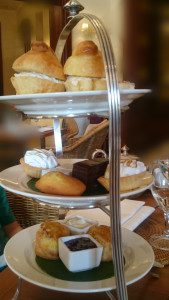
Our destination was the Strand Hotel, a little remnant of colonial times down near the river. Rudyard Kipling, Somerset Maugham, and Noel Coward were said to have spent time here – although a little research shows Kipling clearly never did in reality. In any case, it is considered to be a symbol of colonial times and one of the top places in the World to have high tea. We duly enjoyed high tea under slowly rotating rattan fans and talked of times past and the fact that in spite of Kipling having written some of the most famous poetry and prose about colonial Burma, he spent less than three days in the country.
Walking back to the hotel took us through back-streets of local markets selling everything from underwear to telephones and thronging with countless small stalls selling food that ranged from the appealing to the deeply confronting. Fish on a stick is popular, deep-fried intestines did not look good, but some of the vegetarian options were intriguing. People sit beside the road on plastic chairs, or sometimes with feet dangling into open drains, and eat inches from the stream of cars and buses. And over everything there are exotic smells and constant, blaring noise.
It’s been quite a first day. Here’s one final slightly confusing thing we’ve discovered: We thought that the name ‘Burma’ was a colonial holdover which shouldn’t be used – in the same way ‘Bombay’ and ‘Peking’ are artefacts of the past. However, the situation turns out to be more complex than that. Half the countries of the World and many locals refuse to recognise the change of name to Myanmar on the basis that the military government simply had no power to make the change. So, a bit like driving on the right in cars designed for driving on the left, the result is confusion.
